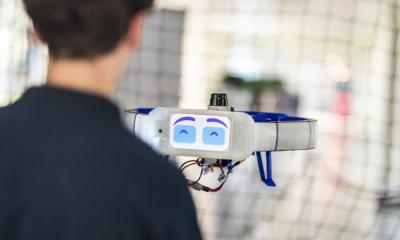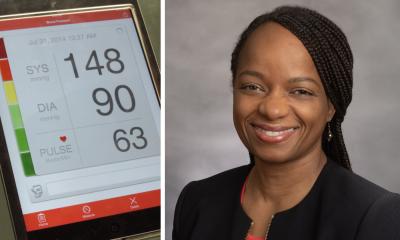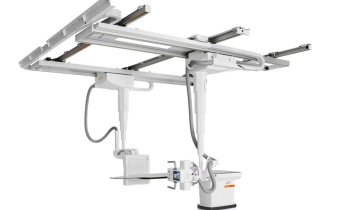
Article • Shaping daily activities for elderly fragile people
Meet 'Tessa' the little robot helper
‘Hello Tessa. Do you know what I’m doing today?’ a fragile, elderly woman asks tentatively. The small robot she’s addressing has a decorative plant on its head and is wearing a jacket. This is not a funny fantasy. Tessa has proved ‘her’ usefulness and acceptability. The little robot results from a year-long pilot project recently completed in the Netherlands by the Groene Kruis Thuiszorg (GKT), part of De Zorggroep. Everyone is now so enthusiastic about Tessa that this will now continue and expand.
Report: Madeleine van de Wouw

During the trial, 65 plug-and-play Tessa robots were deployed among clients in home care. With 1,500 now active – within the next five years a Tessa 'army' could swell to 50,000. That’s the aim of Jan Willem Heeg, partner and COO of Tinybots, developer of the care robot: ‘Thanks to Tessa's efforts, people can remain independent for longer and therefore relieve their daily care.’
The small robot provides verbal guidance to people with cognitive disabilities who thus need daily structure. The robot comes ‘empty headed’ with example scripts. These need adaptation and change by the caregiver, who can set questions, instructions, messages and even music via the app, either remotely and/or on the spot. ‘Which questions or instructions depends on what the client needs,’ Heeg points out. ‘This could be instructions to take a shower, or to take medication. Normally it’s the care giver who sees that those tasks are done and has to wait, perhaps considerable time, to see whether those tasks have not been performed. That time is now saved by using the care robot.’
Tessa asks a question in her own voice, waits for the answer, and sends it to the app. ‘This allows the caregiver to monitor everything. If there is no answer, Tessa asks the question again. It is technically possible to do more, but that can become too complicated for the users,’ Heeg points out. ‘You don’t want this target group to have real conversations and thus get the opportunity not to follow instructions. That’s why we choose questions that are closed within a pre-set time frame and they can only be answered with a “yes” or “no”.’

‘The pilot project shows that Tessa works very well for people with cognitive disabilities,’ confirms Roland Beerens, Tessa project manager at De Zorggroep. ‘They suffer less from their condition if they receive assistance in this way. The results for people with more advanced dementia are mixed so, for the time being, we prefer to use the robot for people who need a lighter form of supportive care.’
However, Heeg adds, ‘Tessa is getting smarter. She can generate her own scripts, starts to understand speech and could, for the appropriate target group, have more complex conversations. Then, in the future, there may be a link to “blended care”. We then could link the interface to other domotics [home robotics], such as a smart cup or sensors. Tessa can, for instance, give an order to drink something and the smart cup indicates whether this can actually happen.’
Tessa’s lifespan is unknown, but some robots have been in use for more than three years. Connecting the robot only to mains electricity is a conscious choice, Heeg explains. ‘Remember that the target group is people with cognitive disabilities. Because she is attached to a wire, she is much less easy to move, for example, to a place where she doesn’t function well.’
In practice, and technically, great strides have been made in the last two years. Research for updates is now done automatically and Tessa can easily move on to the next client: just wash her ‘coat’, clean the body, give her a new plant and new instructions, and she's ready to go.
Heeg likes the fact that Tessa, with her current appearance and voice, was developed in collaboration with users and care providers. ‘It's amazing how much you can achieve with something so simple. ‘To keep in touch, we all take turns working on the helpdesk. That’s a reality check for us and the place we hear the best stories. Example: one client was only lying in bed and had all sorts of bedsores. ‘Tessa activated him, even to the extent that he started to use his exercise bike again. The caregiver was incredibly surprised and did not even know he had one.’
Another positive example: A lady had to change her bandages every day but kept forgetting. Thanks to Tessa she now does this every day and feels much more independent. She has regained her spirit. The robot makes people feel less lonely, prompts them to eat again, take their medication on time, exercise more and become more active. Healthcare staff need to pay less attention. On average, about two hours per client per week is saved.
Of all the clients, 89% had demonstrably less trouble with their care needs. With the shortage of people in care, it turns out that Tessa really contributes to relieving the burden of care
Roland Beerens
Beerens is also very positive about Tessa's effects, as are the care workers at De Zorggroep. The 40 employees who participated in the evaluation achieved a Net Promoter Score (NPS) of no less than 41%. They see that the care robot indeed makes a client more self-reliant and at the same time improves quality and efficiency of care. They indicate that a patient’s quality of life is greatly enhanced by giving them self-control.
The pilot study showed that care provision at a distance works against loneliness. ‘Of all the clients, 89% had demonstrably less trouble with their care needs. With the shortage of people in care, it turns out that Tessa really contributes to relieving the burden of care,’ Beerens emphasises.
For the time being, Tessa can only be deployed via care providers. It is also important that health insurers reimburse for Tessa. ‘De Zorggroep is now entering the Tessa implementation phase,’ says Beerens. ‘The goal is to deploy at least two Tessas in each of the 80 or so homecare units this year. The expectation is that the implementation will be completed before 1 July 2021 and that Tessa will then be a standard part of the services provided by De Zorggroep's district nursing service.’
Profiles:
Partner and COO of Tinybots Jan Willem Heeg MSc (Industrial Engineering & Management), has over eight years’ international experience in business development.
Wang Long Li, founder of Tinybots, researched how robots could be used in healthcare. With a background in technical product development and psychology, he studied how this new technology could support various vulnerable target groups. From a human/design perspective, the first prototypes were developed along with the target groups, informal carers and care providers.
Roland Beerens has spent 20 years in Marketing and Customer Services in various industries, such as Telco, IT and Financial Services and Care. A specialist in online and offline customer oriented innovation, in the boardroom he raises support for customer programmes.
17.03.2021







